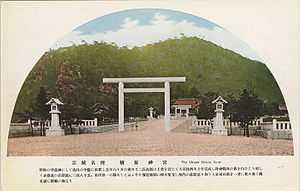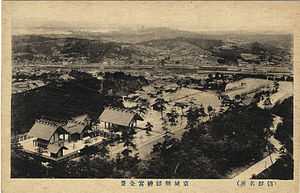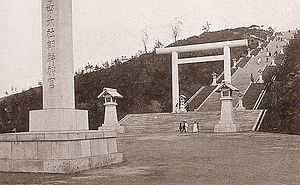Chōsen Jingū




Chōsen Jingū (朝鮮神宮) was the most important Shinto shrine in Korea from 1925 to 1945, during the period of Japanese rule.
Background
After the annexation of Korea in 1910, the Japanese government embarked upon a policy of Japanization. This included worship at Shinto shrines, as much a political expression of patriotism as a religious act.[1][2] From 1925, school pupils were required to attend Shinto shrines, and in 1935 it became compulsory for university students and government employees to attend Shinto ceremonies.[3][4] By 1945, there were a total of 1,140 shrines in Korea associated with State Shinto.[3]
Chōsen Jingū
Chōsen Jingū was erected in 1925 on the peak of mount Namsan in Seoul and was dedicated to Amaterasu and Emperor Meiji. It was constructed in the shinmei-zukuri style of Ise Jingū.[5][6] Chōsen Jingū was demolished in October 1945, several months after Korea became independent, and in 1970 the "Patriot An Chung-gun Memorial Hall" was constructed on the site of the former shrine, in honour of An Chung-gun, the assassin of Itō Hirobumi, the first Japanese Resident-General.[2][7]
See also
References
- ↑ Sung-Gun Kim (1997). "The Shinto Shrine Issue in Korean Christianity under Japanese Colonialism". Journal of Church and State 39: 503.
- ↑ 2.0 2.1 Wakabayashi, Ippei. "Ahn Jung-geun and the Cultural Public Sphere". Bunkyo University. Retrieved 31 March 2011.
- ↑ 3.0 3.1 Grayson, James H. (1993). "Christianity and State Shinto in Colonial Korea: A Clash of Nationalisms and Religious Beliefs". Diskus (British Association for the Study of Religions). 1 (2): 13–30.
- ↑ Wagner, Edward W. et al. (1990). Korea Old and New: A History. Harvard University Press. p. 315. ISBN 0-9627713-0-9.
- ↑ "Chōsen Jingū". Genbu.net. Retrieved 31 March 2011.
- ↑ Hiura, Satoko (2006). "朝鮮神宮と学校 : 勧学祭を中心に". Japan Society for the Historical Studies of Education (National Institute of Informatics) 49: 110–112.
- ↑ Keene, Donald (2002). Emperor of Japan: Meiji and his World, 1852-1912. Columbia UP. pp. 664ff.
External links
(Japanese) Chōsen Jingū (plan and photographs)
Coordinates: 37°33′13″N 126°58′58″E / 37.55361°N 126.98278°E